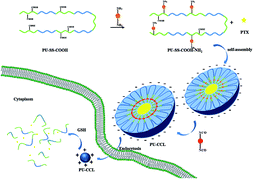Surface charge switchable and core cross-linked polyurethane micelles as a reduction-triggered drug delivery system for cancer therapy†
Abstract
The extracellular stability versus intracellular drug release and the long blood stream circulation versus enhanced cell uptake are two dilemmas for micellar drug delivery systems. To resolve the above two problems, a novel core cross-linked polyurethane micelles with redox sensitive and pH-responsive surface charge switchable properties were prepared and investigated as anti-cancer drug carriers. Firstly, amphiphilic multi-blocked polyurethane with pendant carboxyl groups and disulfides in the hard segment (PU-SS-COOH) was synthesized. Afterwards, 1,6-diaminohexane was connected onto some of the pendant carboxyl groups via dicyclohexylcarbodiimide (DCC) condensation, which resulted in polyurethane with pendant amine and carboxyl groups (PU-SS-COOH-NH2). Then the PU-SS-COOH-NH2 was assembled into micelles and the hexamethylene-1,6-diisocyanate (HDI) was added into the micelle solution. The hydrophobic diisocyanate penetrated into the hydrophobic core of PU micelles and reacted with amine groups, which resulted in core crosslinked PU micelles (PU-CCL). PTX and doxorubicin hydrochloride (DOX) were chosen as model hydrophobic drugs to evaluate the loading and redox-triggered release of the PU micelles. The drug release from the cross-linked polyurethane micelles (PU-CCL) demonstrated that the PU-CCL has superior particle stability compared with the uncross-linked polyurethane micelles in a phosphate buffer saline (PBS) solution without reducing agents, whereas the drug release rate is markedly accelerated with the addition of a reducing agent, glutathione (GSH). Notably, PU micelles with both amine and carboxyl groups, i.e. PU-SS-COOH-NH2 and PU-CCL micelles, showed pH-responsive charge switchable properties. The in vitro cytotoxicity and cell uptake of the PTX (or DOX used to illustrate the cell uptake) loaded micelles was also assessed in HepG2 cells. It was found that the redox-sensitive polyurethane micelles can rapidly enter tumor cells. In vitro cytotoxicity studies demonstrated that the DOX-loaded PU-CCL display lower cytotoxicity in vitro compared to either free DOX or DOX-loaded uncrosslinked PU micelles. The cross-linked reduction responsive biodegradable micelles, having superior extracellular stability and providing rapid intracellular drug release, may hold great potential as a bio-triggered drug delivery system for cancer therapy.


 Please wait while we load your content...
Please wait while we load your content...